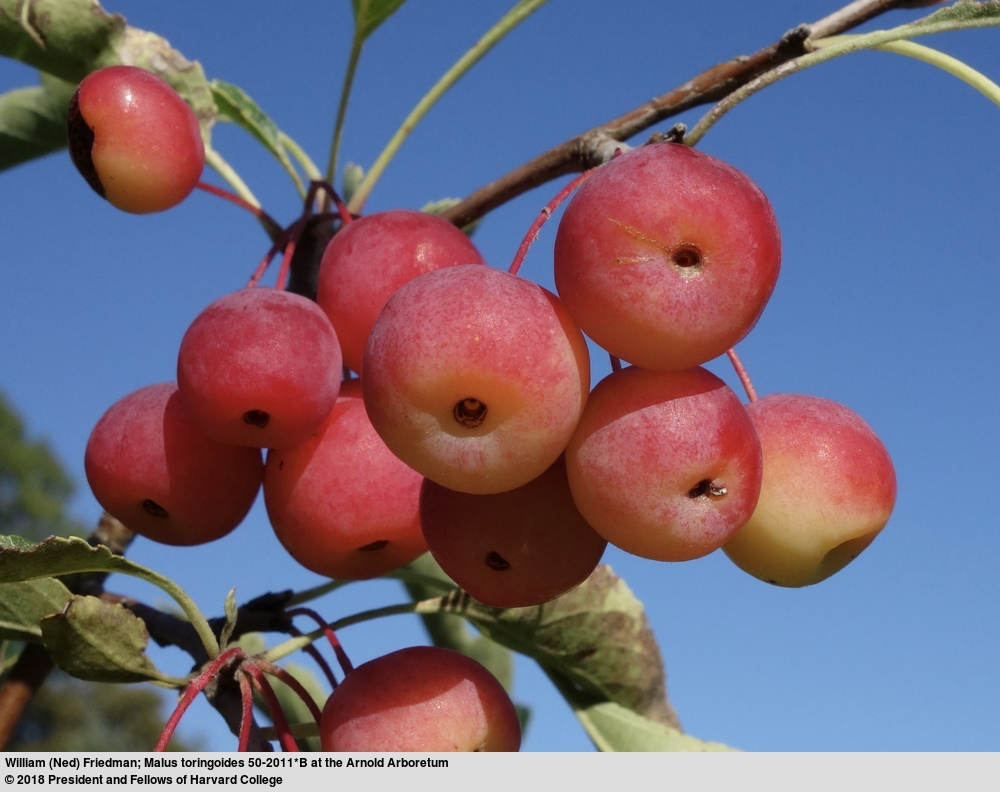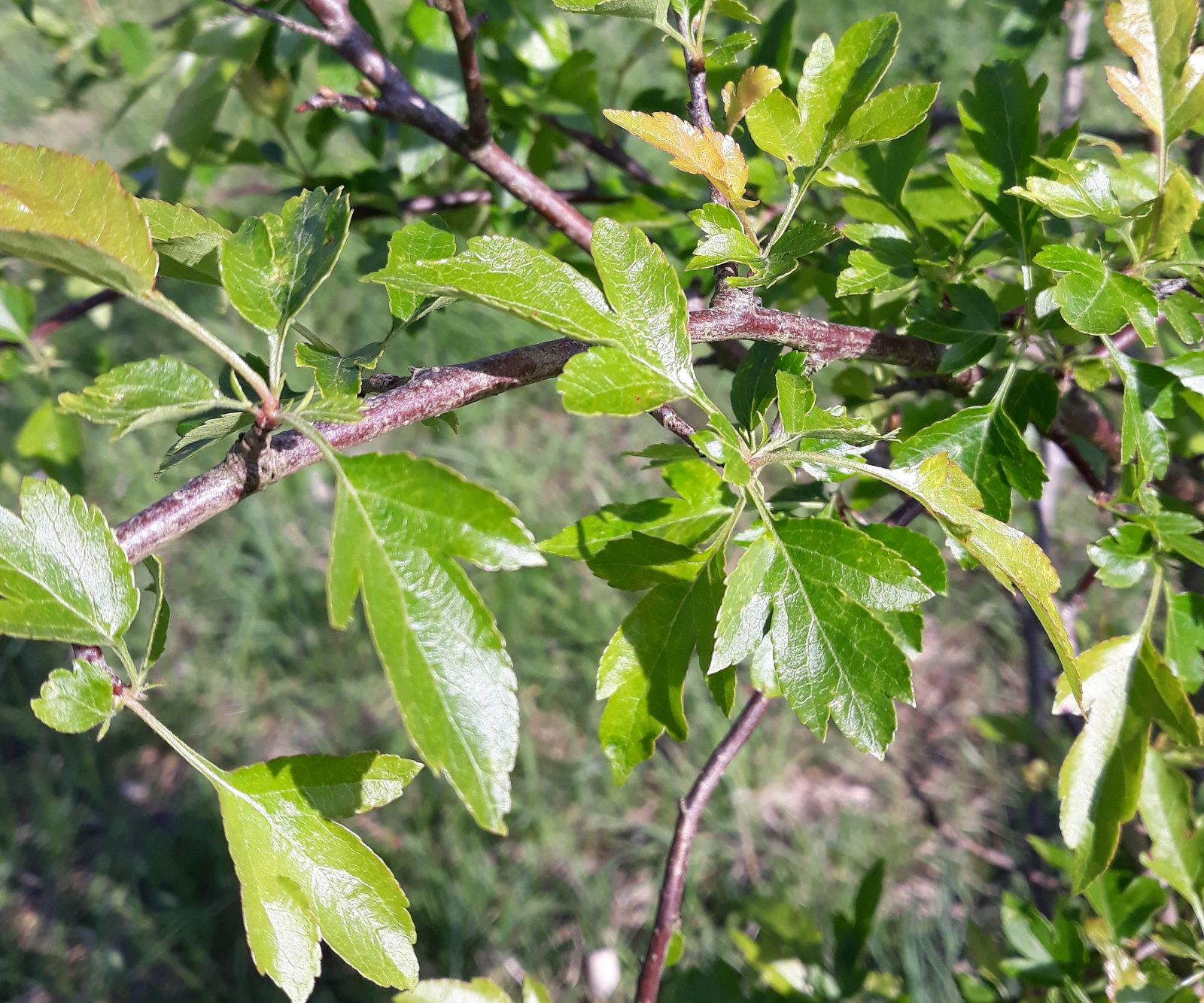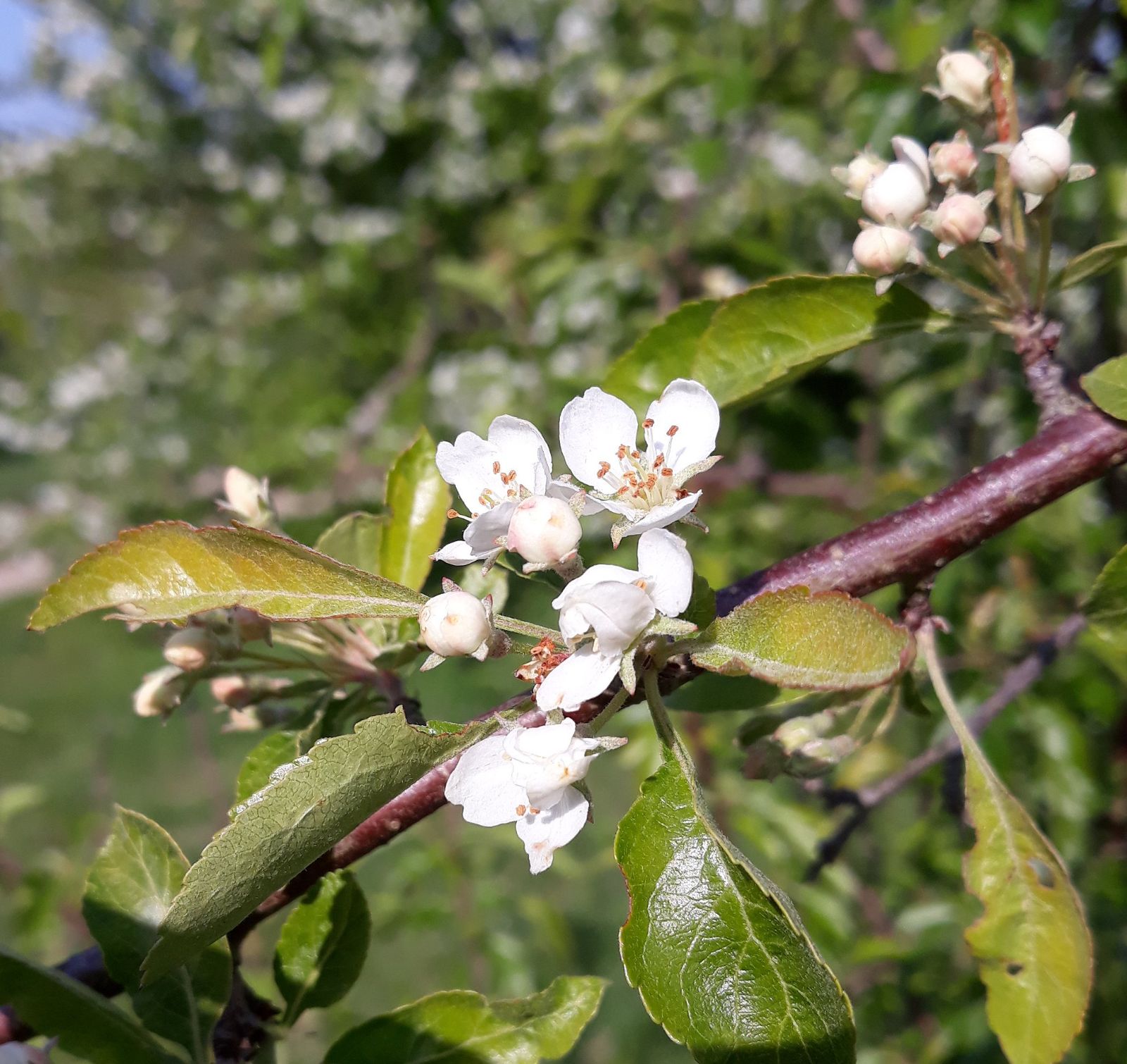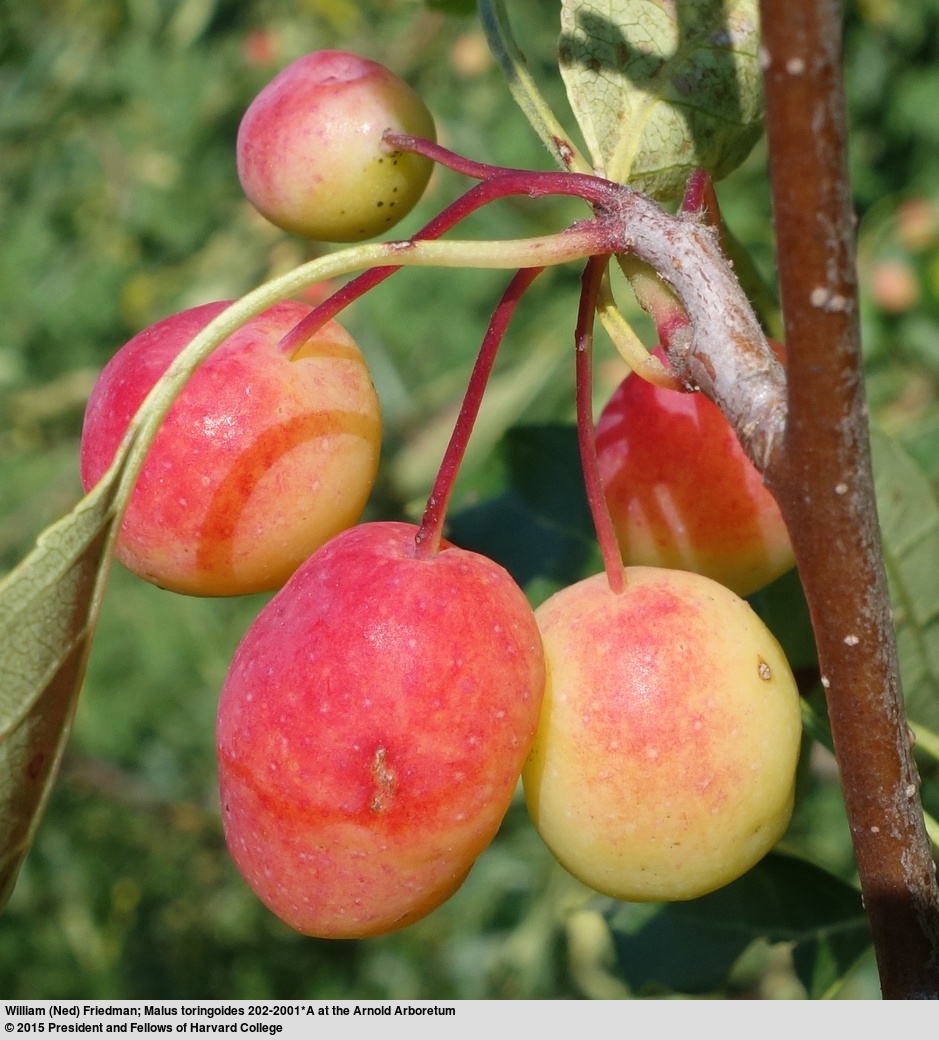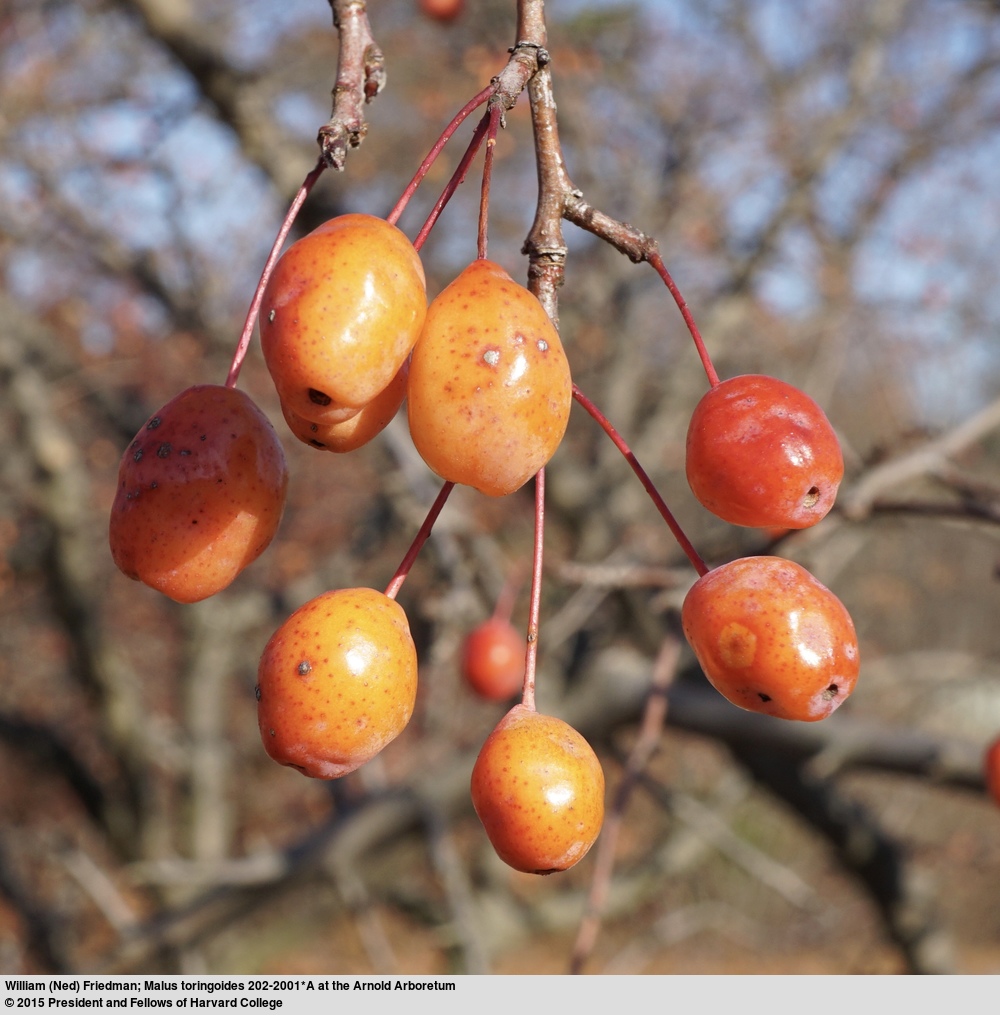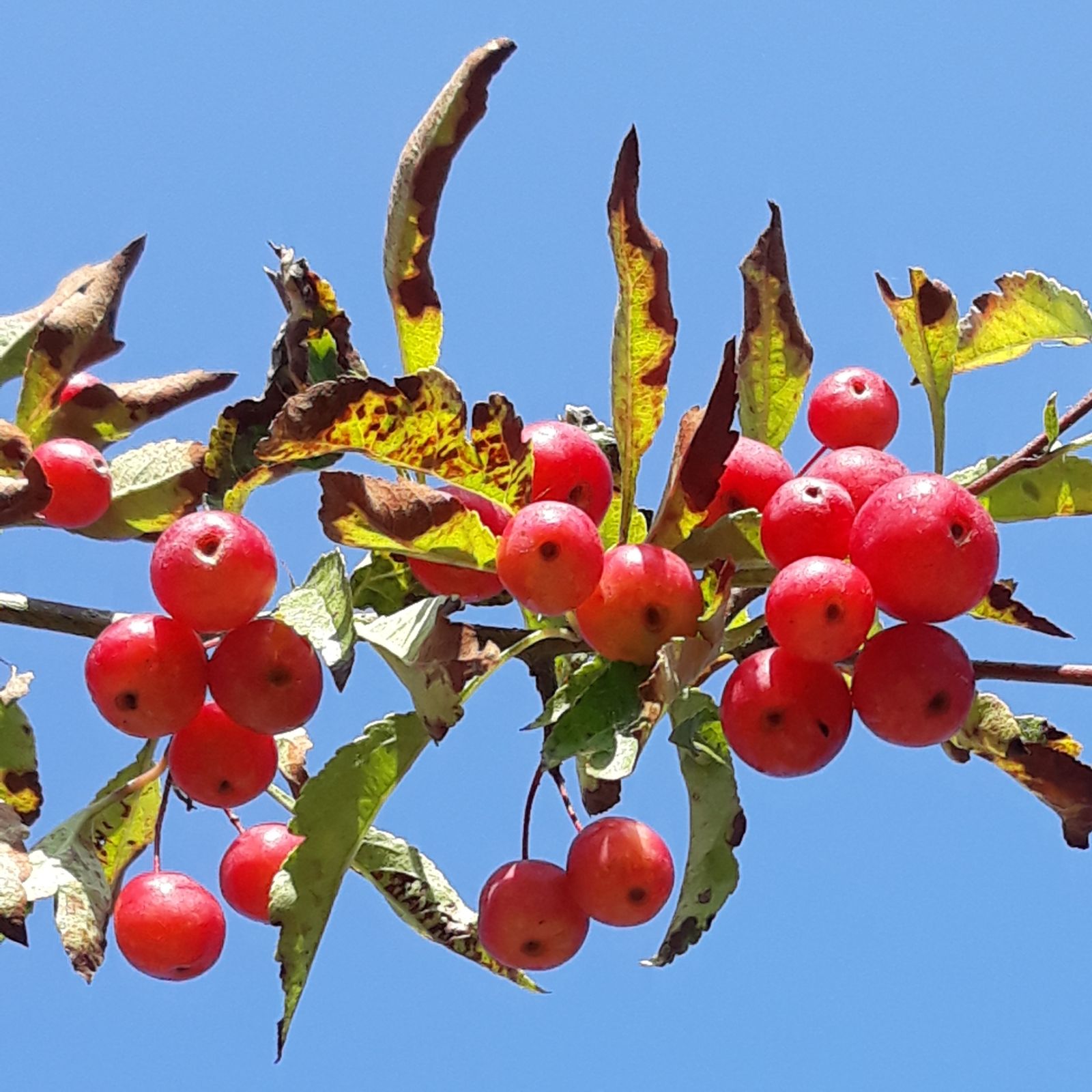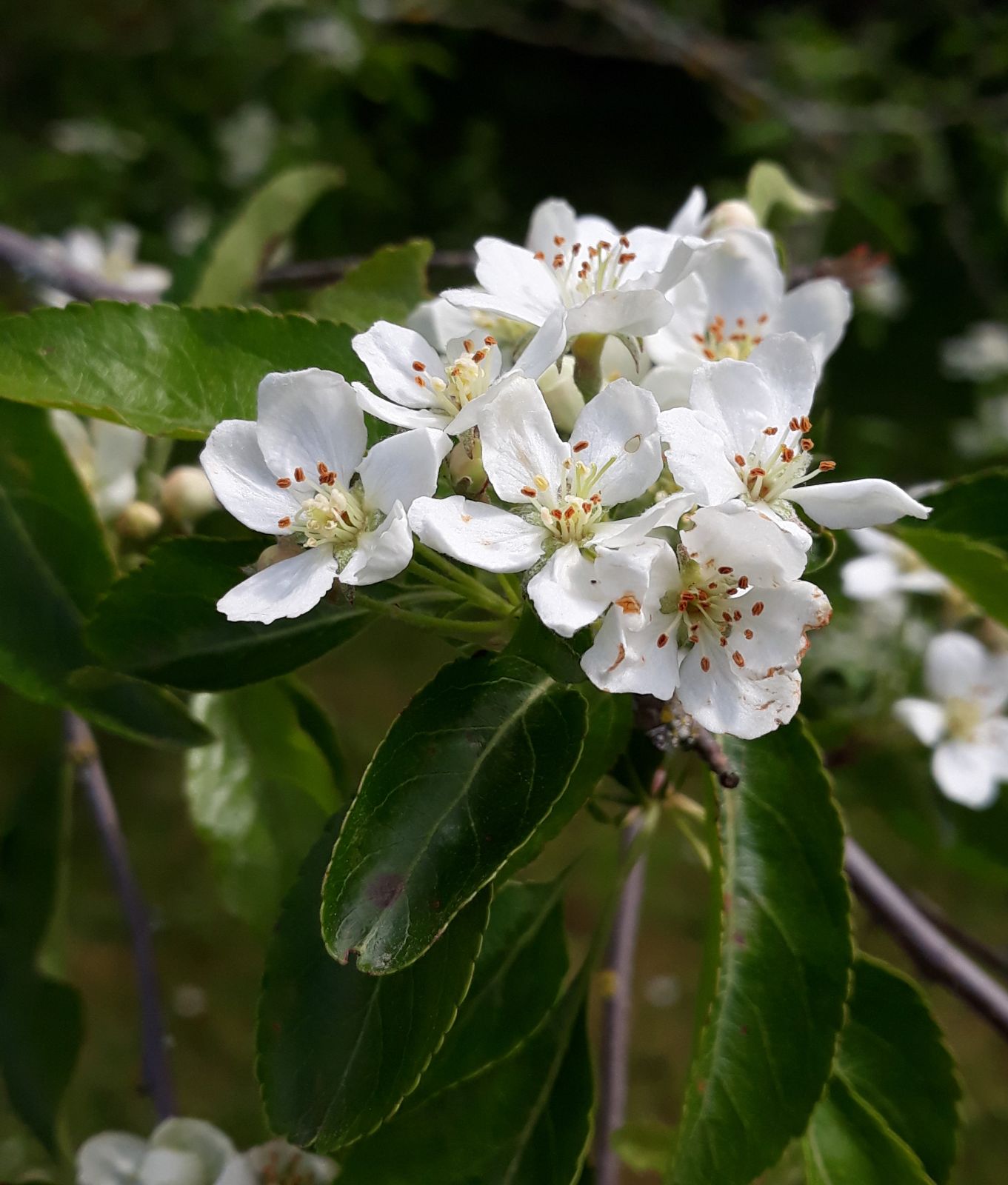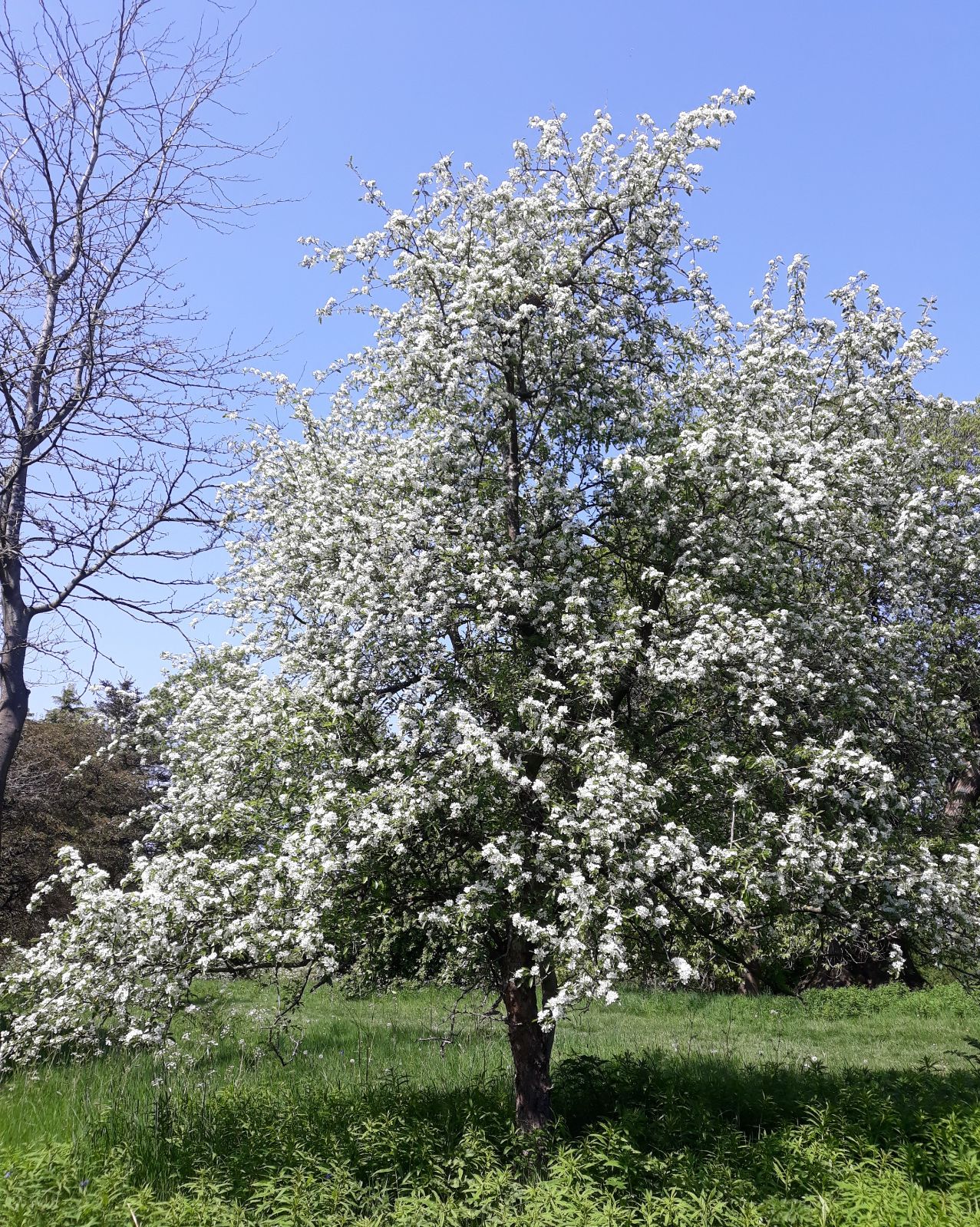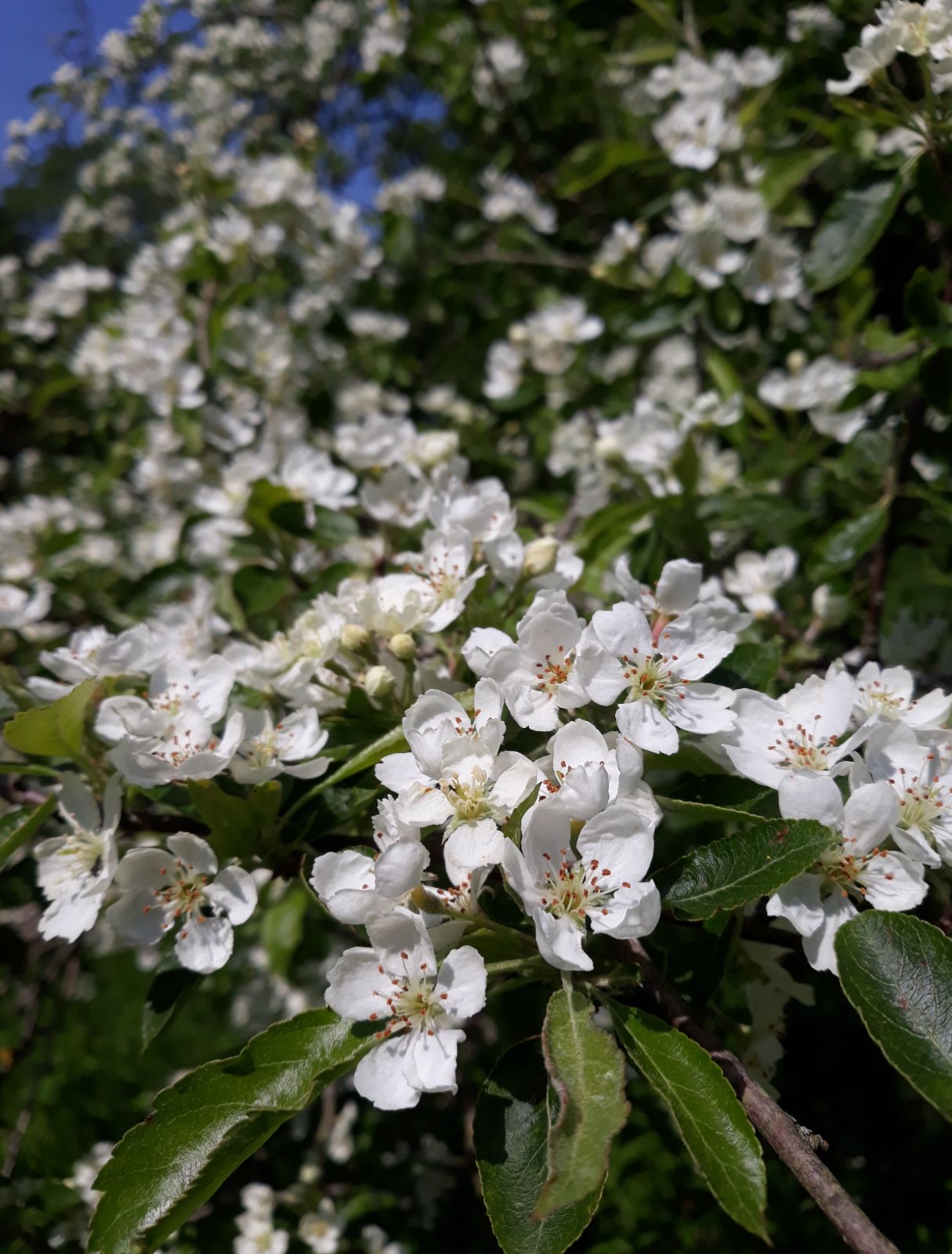Malus bhutanica
Sponsor
Kindly sponsored by
Francine: 'after many informative Tours and Study Days with the IDS I feel it only fitting to help and promote such a wonderful organisation'
Credits
Julian Sutton (species), Nick Dunn (cultivars) (2021)
Recommended citation
Sutton, J. & Dunn, N. (2021), 'Malus bhutanica' from the website Trees and Shrubs Online (treesandshrubsonline.
Genus
Common Names
- Cut-leaf Crabapple
- bian ye hai tang
Synonyms
- Malus toringoides (Rehd.) Hughes
- Malus transitoria var. toringoides Rehd.
- Pyrus bhutanica W.W. Smith
- Sinomalus bhutanica (W.W. Smith) Rushforth
Infraspecifics
Other taxa in genus
- Malus × adstringens
- Malus angustifolia
- Malus × arnoldiana
- Malus asiatica
- Malus × astracanica
- Malus × atrosanguinea
- Malus baccata
- Malus × brevipes
- Malus chitralensis
- Malus coronaria
- Malus crescimannoi
- Malus Cultivars A-B
- Malus Cultivars C
- Malus Cultivars D-F
- Malus Cultivars G-I
- Malus Cultivars J-K
- Malus Cultivars L-M
- Malus Cultivars N-Q
- Malus Cultivars R
- Malus Cultivars S
- Malus Cultivars T-Z
- Malus dasyphylla
- Malus × dawsoniana
- Malus domestica
- Malus doumeri
- Malus florentina
- Malus × floribunda
- Malus fusca
- Malus × gloriosa
- Malus halliana
- Malus × hartwigii
- Malus × heterophylla
- Malus honanensis
- Malus hupehensis
- Malus ioensis
- Malus kansuensis
- Malus kirghisorum
- Malus komarovii
- Malus × magdeburgensis
- Malus × micromalus
- Malus × moerlandsii
- Malus montana
- Malus ombrophila
- Malus orientalis
- Malus × platycarpa
- Malus praecox
- Malus prattii
- Malus prunifolia
- Malus × purpurea
- Malus × robusta
- Malus rockii
- Malus Rootstock Cultivars
- Malus Rosybloom Cultivars
- Malus × scheideckeri
- Malus sieversii
- Malus sikkimensis
- Malus × soulardii
- Malus spectabilis
- Malus spontanea
- Malus × sublobata
- Malus sylvestris
- Malus toringo
- Malus transitoria
- Malus trilobata
- Malus tschonoskii
- Malus turkmenorum
- Malus yunnanensis
- Malus × zumi
Shrub or small trees, 3–6 m. Branchlets purplish-brown and very finely hairy when young, glabrous later. Buds purplish brown, ovoid with acute tip, pubescent. Leaf blade variable in shape, ovate or narrowly elliptic, 3–8 × ~1.5 cm, sparsely pubescent above at first, densely pubescent on the veins beneath; base cuneate to subcordate; apex acute; margin with obtuse teeth, usually 2–5 lobed on the long shoots; petiole 1–3 cm, very finely hairy. Inflorescence a 3–5-flowered corymb; pedicels 1.8–2.5 cm, sparsely hairy. Flowers ~2 cm across, slightly fragrant, in late spring (April-May in the wild). Sepals falling before fruit is ripe, triangular-lanceolate, 3–4 mm, with felted white hairs on both surfaces; petals white, ovate to obovate, 8–11 mm, sometimes sparsely pubescent above; stamens about 20, unequal, shorter than the petals; styles 3(–5), not exceeding stamens. Fruit yellow, tinged red on sunny side, August-September in the wild, spherical to almost pear shaped, 1–1.5cm diameter. (Gu et al. 2003; Cullen et al. 2011; Bean 1981).
Distribution China SE Gansu, W Sichuan, SE Xizang.
Habitat Thickets on slopes, 2000–3600 m asl.
USDA Hardiness Zone 5b-8
RHS Hardiness Rating H5
Conservation status Data deficient (DD)
Malus bhutanica – still better known as M. toringoides – stands out among the small-fruited East Asian species with deciduous calyces as a beautiful small tree. Making a rather broad, open crown of slender branches, it can produce a good show of lightly fragrant, creamy white flowers with downy calyces. The strikingly lobed leaves colour well in autumn. Fruits are abundant and conspicuous, reddening with age and exposure to sun; at a peak in September and October, they are often retained into December (Bean 1981; Edwards & Marshall 2019; van den Berk Nurseries 2020).
M. bhutanica is most like M. toringo and M. transitoria in general appearance. Following the Flora of China (Gu et al. 2003), it differs from M. toringo in having sepals tomentose on both sides, rather than only above, and in the veins of the leaf undersurface being densely pubescent; M. transitoria is tomentose across both leaf surfaces. Diploids, triploids and tetraploids have been recorded in M. bhutanica (Gu et al. 2003). Molecular evidence gives some support to the idea that it arose from hybridization between M. transitoria and M. kansuensis (Feng et al. 2007), but there is much more to discover about polyploid speciation in this group of apples.
There is confusion around the correct name of this plant. The familiar name M. toringoides was first applied (as M. transitoria var. toringoides) by Rehder in Sargent (1916) from specimens collected above 3000 m in western Sichuan in 1904 (Wilson for Veitch 3494) and 1908 (W 1285). However, a specimen belonging here had previously (1911) been given the valid but long overlooked name Pyrus bhutanica, published as a new combination in Malus by Phipps (1994). There is no suggestion that the tree is native to Bhutan, and the type specimen was taken from a cultivated tree in a Tibetan monastery. A proposal exists to conserve the familiar name (Qian et al. 2008), but it remains to be seen what consensus will be reached. We follow the latest horticultural usage in using M. bhutanica (e.g. Edwards & Marshall 2019), but expect both names to be current for the foreseeable future. We emphasize that for once this is purely a matter of nomenclature rather than identification.
Wilson also collected seed in Sichuan, under Wilson for Veitch 1730 in 1904, W 1285 in 1908, and perhaps other, later numbers (Sargent 1916; Arnold Arboretum 2020). An original specimen from a Wilson collection survives at Sheffield Park, Sussex in a much decayed state (The Tree Register 2020). Other significant examples can be seen in collections scattered across Britain, from Furzey Gardens, Lyndhurst, Hampshire (13 m × 134 cm, 2017) to the Cruickshank Botanic Garden, Aberdeen (8 m × 107 cm, 2018 – The Tree Register 2020), although as always with Malus species an open-minded attitude to identification is prudent. There are several established trees of Sichuan provenance at the Yorkshire Arboretum, from a Kim Sorvig collection made at 3500 m in 1981, and from SICH 2225 made in 2001, the latter a ‘scrappy tree of no ornamental value’ (J. Grimshaw, pers. comm. 2020). Roy Lancaster’s L 926 of 1981 is another relatively recent introduction (Clarke 1988). In continental Europe there are records of two old trees at Gothenburg Botanic Garden, Sweden, one each at Amsterdam Botanic Garden and Bonn University Botanic Garden, and one of wild provenance at the Arboretum Wespelaar, Belgium (Gothenburg Botanical Garden 2020; Hortus Botanicus Amsterdam 2020; Botanische Gärten der Universität Bonn 2020; Arboretum Wespelaar 2020). Even as far north as central Norway, it forms an upright tree at Ringve Botanical Garden, Trondheim (NTNU University Museum 2020). While not exactly mainstream, unselected Malus bhutanica finds its way into amenity plantings and is offered by some large European tree nurseries (van den Berk Nurseries 2020).
This is a rare tree in North American cultivation, although hardy both in the Northeast and the Pacific Northwest. Comments in the American literature are strikingly less positive than those from Britain. Jacobson (1996) – a rather severe judge of crabapples – says of the fruit ‘in spite of its abundance, the sight is not heartwarming’; a westerner, he likens the flowers to those of M. fusca, to which it might be quite closely related. There are several examples in the Arnold Arboretum, MA, including two repropagated from W 1285 (the larger 19 cm basal diameter in 2015 – Arnold Arboretum 2020). Multiple trees are also recorded at the Morton Arboretum, IL and the Hoyt Arboretum, OR (Morton Arboretum 2020; Hoyt Arboretum 2020). A record from the Guelph Arboretum, Ontario, of a tree of North Korean provenance labelled as this western Chinese species (University of Guelph 2020) serves to highlight how difficult these wild apples can be to identify, and how cautious one must be in interpreting their literature.
'Mandarin'
A relatively narrow-crowned clone introduced in 1997 by the Netherlands Inspection Service for Horticulture (NAKB), from material sent by East Malling Research Station, Kent, UK; marketed in Europe for street planting.
Growth Rate/Size: Large (>6 m)
Form/shape/habit: Broadly pyramidal
Foliage: Dark green, lobed; good autumn colour
Flower colour: White
Flower size: Medium (<3 cm)
Flower form: Single
Flower season: Late
Fruit size: Small (<2 cm)
Fruit shape: Round
Fruit colour: Yellow with red blush
Disease resistance/susceptibility: Resistant
(Description duplicated under Malus Cultivars L-M ‘Mandarin’)

